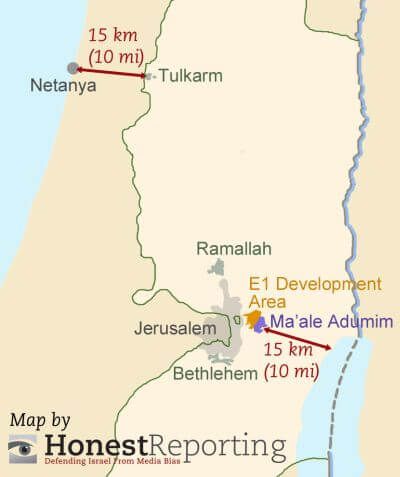The case of the Bedouin encampment Khan al-Ahmar has become a cause célèbre for many foreign media outlets as well as European governments and non-governmental organizations.
After a decade-long legal battle, Israel’s High Court of Justice ruled in September that the Bedouins failed to demonstrate ownership of the land, clearing the way for the government to demolish the ramshackle collection of structures located right next to a main highway east of Jerusalem between the Israeli settlements of Ma’ale Adumim and Kfar Adumim. Currently, the demolition order has been frozen on orders of Israeli Prime Minister Benjamin Netanyahu in order to continue the search for a solution that avoids removing the Bedouin residents by force.
That the case has been framed almost entirely as a ‘human rights’ issue has skewed the coverage. After all, cold facts and legal arguments carry little weight when confronted with images of Israeli soldiers and bulldozers ranged against screaming Bedouin women and children fighting for their homes.
Join the fight for Israel’s fair coverage in the news
It’s these scenes that dominate a five and a half minute video report from the Financial Times that deliberately frames the dispute against Israel with scant regard for Israel’s side of the argument. (And yes, it is an argument with two sides as demonstrated by the exhaustive legal battle that has taken place.)
Let’s look at the language that the FT’s Mehul Srivastava uses to frame the dispute:
Both these villagers and Palestinian leaders expect Israeli bulldozers to demolish these few dozen huts. That would bring an end to a nearly half-century standoff between Jewish settlers and Arab villagers in the West Bank . . . .
This tiny, dusty village has catapulted onto the global stage because of one simple fact, its location. Planted between two illegal Israeli settlements, Kfar Adumin, and Ma’ale Adumin, its very existence jeopardises expansion of Israeli infrastructure in the West Bank. Full Israeli control of this land would separate Ramallah and Bethlehem, the two largest Palestinian cities. If successful, it would dash the hopes of a viable Palestinian nation.
In the eyes of some media, there is nothing more pejorative and negative than Israeli “settlers.” Therefore, framing this particular dispute as a “nearly half-century standoff between Jewish settlers and Arab villagers” ensures that the viewer already knows who the good guys and bad guys are in this argument.
By referring to “two illegal Israeli settlements,” it is quite clear where the journalist is coming from. With no context to this blanket statement, any Israeli actions described in the video will, by definition, also be judged illegal in the eyes of the viewers. For a fuller explanation of Israeli arguments for the legality of settlements, see Eugene Kontorovich, Mitchell Bard, Eugene Rostow, Moshe Dann and Jeffrey Helmreich.
Khan al-Ahmar is located in the proposed development zone known as E1, on which Israeli building has been touted for many years in the face of Palestinian and international protests.

So, as the FT claims, would construction here “separate Ramallah and Bethlehem” and “dash the hopes of a viable Palestinian nation”?
Well, the New York Times issued a correction in 2012 debunking the very points now raised by FT:
An article on Dec. 2 about Israel’s decision to move forward with planning and zoning for settlements in an area east of Jerusalem known as E1 described imprecisely the effect of such development on access to the cities of Ramallah and Bethlehem from Jerusalem, and on the West Bank. Development of E1 would limit access to Ramallah and Bethlehem, leaving narrow corridors far from the Old City and downtown Jerusalem; it would not completely cut off those cities from Jerusalem. It would also create a large block of Israeli settlements in the center of the West Bank; it would not divide the West Bank in two. And because of an editing error, the article referred incompletely to the possibility of a contiguous Palestinian state. Critics see E1 as a threat to the meaningful contiguity of such a state because it would leave some Palestinian areas connected by roads with few exits or by circuitous routes; the proposed development would not technically make a contiguous Palestinian state impossible.
The FT video says:
Meanwhile, some 400,000 Jews have been given permission to build vast, sprawling settlements. Under international law, the settlements are illegal. Under Israeli law, Khan al Ahmar is illegal.
Again, there is no mention that Israel disputes this interpretation of international law. Even the BBC includes this information when discussing settlements. And are all settlements “vast” and “sprawling”? Given that settlements range in population from a few hundred to tens of thousands of residents, it’s simply hyperbole for Srivastava to employ this description.
If the FT is so concerned with international law, Srivastava could have noted that the European-built school in Khan al-Ahmar raises issues of the legality of European states themselves breaking international law by funding building projects in Area C of the West Bank.
(Dore Gold argues that the presence of Khan al-Ahmar actually violates the Oslo Accords in the video below.)
While a spokesperson for the Israeli non-governmental organization Regavim was interviewed, the amount of time she was featured didn’t allow viewers to get a full understanding of Israel’s position or provide balance against more extensively quoted Bedouin resident and the community’s Israeli lawyer.
Indeed, the FT fails to note the Israeli government’s own stated efforts to avoid demolishing Khan al-Ahmar by force, preferring to exhaust other options. As The Times of Israel recently reports:
A more recent proposal under consideration is reportedly a suggestion to move the village away from the Route 1 highway by some 500-1,000 meters northwestward, away from the dangerous road and lands claimed by the nearby settlement of Kfar Adumim and onto plots of land owned by the Palestinian village of Anata. Israeli authorities have long argued that the village’s proximity to the highway was a safety threat both to the highway and to the villagers.
The idea of moving the hamlet several hundred meters away, including to the Anata-owned plots, was first raised by the residents of Khan al-Ahmar themselves some three years ago, then again six months ago.
The FT also failed to mention that the residents of Khan al-Ahmar were offered relocation to somewhere nearby where they would have access to the basic infrastructure that they currently lack such as running water and electricity. By all means debate the merits of that location and the reasons why the Bedouin have so far rejected such a move. However, framing Israeli actions as simply making Arabs homeless without any consideration for their welfare is deliberately meant to falsely portray Israel as a state lacking in any humanity.
The Khan al-Ahmar issue has become a significant international story that deserves to be covered with the nuance that such a complicated case deserves. The Financial Times has singularly failed to do this in its video report.
Please send your considered comments about this video to the Financial Times – [email protected]


